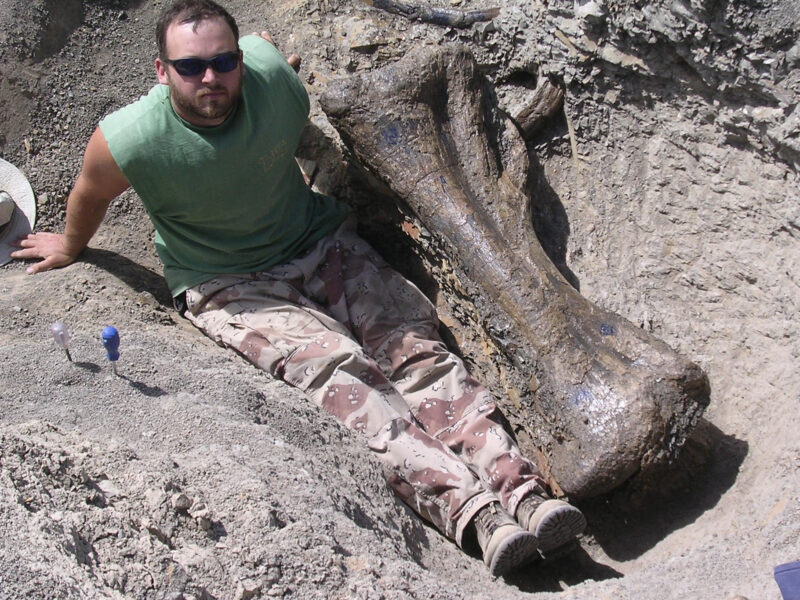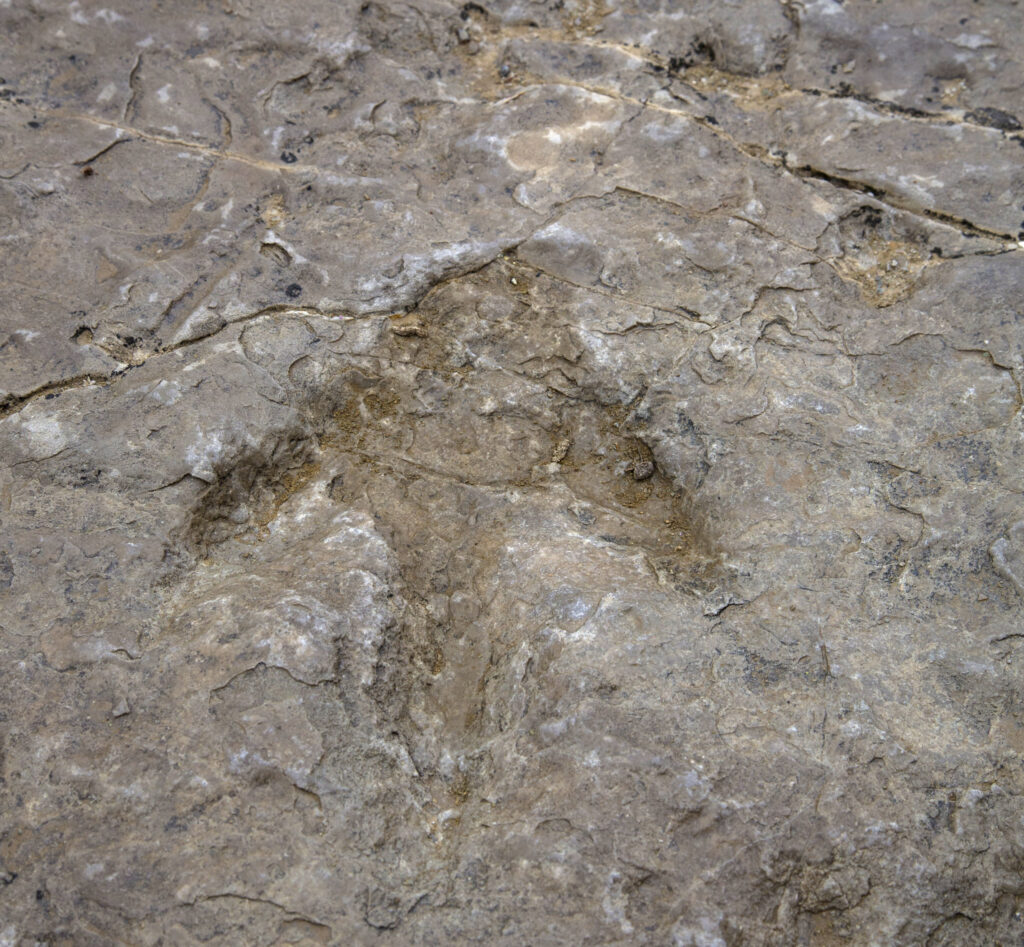Bighorn Basin has Dinosaurs ‘Everywhere’
Paleontologist details why northwestern Wyoming hosts abundant fossils
- Published In: Other News & Features
- Last Updated: Aug 06, 2023

Paleontologist Jason Schein compares his own size to that of a fossilized tibia from a dreadnaughtus dinosaur, an 85-foot-long sauropod from the Cretaceous Period. (Courtesy photo from Elevation Science Institute)
By Ruffin Prevost
Special to the Wyoming Truth
CODY, Wyo. — Many amateur dinosaur enthusiasts, and even some career paleontologists, have a lifelong wish to find the fossilized remains of a tyrannosaurus, diplodocus or triceratops.
But Jason Schein is a little sick of finding triceratops.
“Triceratops—those things are just everywhere,” he said Thursday during a lecture at the Buffalo Bill Center of the West. “Seriously, triceratops are just a dime-a-dozen. It’s almost a little frustrating.”
All joking aside, Schein, a paleontologist at the Academy of Natural Sciences of Drexel University in Philadelphia, described a region so rich in dinosaur remains that even the amateur, volunteer members of his field crew can’t help but stumble upon dinosaur fossils.
“Within five minutes, I can show you what dinosaur bones look like. Then within 10 minutes out in the field, I can show you what they look like in the ground. And you just start seeing it everywhere,” he said.
This promised land of abundant dinosaurs isn’t in a far-flung locale famous for fossils, like China’s Henan province. Nor is it at a famous U.S. site like Dinosaur National Monument in Utah. It is the Bighorn Basin, an arid, sprawling, sparsely populated expanse of small towns, public lands and large, private ranches stretching across 100 miles of northwestern Wyoming and reaching into southern Montana.
“There are places out there where you literally cannot walk without stepping on dinosaur bones,” Schein told a standing-room-only crowd at the Center’s Coe Auditorium.

As founder of the nonprofit Elevation Science Institute, Schein has been leading paleontological expeditions in the Bighorn Basin since 2010, digging at sites stretching from near Powell to around Bridger, Montana.
The fossils he and others might find in the Bighorn Basin range from ancient plants and invertebrates to familiar Late Cretaceous favorites like the ferocious tyrannosaurus, the duck-billed hadrosaurs, the heavily armored ankylosaurus and the ubiquitous triceratops.
The Bighorn Basin’s unique geology — both during the era of dinosaurs and today —makes it a uniquely productive place for fossil hunting, Schein said.
For a bone, leaf or other organic matter to become fossilized, it must be captured and preserved in a sedimentary layer, something that typically happens around rivers, swamps, lakes and shallow inland seas. Between 70 and 150 million years ago, the Bighorn Basin sat at a spot where rivers emptied into a shallow ocean formed during a much hotter global climate pattern.
Revolutionary discoveries
“What makes the Bighorn Basin so great is that for almost the last 500 million years, almost without interruption, we had rivers or oceans covering this area,” Schein said.
Vast stretches of high desert around the Wyoming communities of Cody, Powell, Lovell and Shell that today could be called badlands were quite similar in climate during the age of dinosaurs to coastal Louisiana today, he said.
Other places might share a similar prehistoric profile, but it’s also the Basin’s present-day geology that makes it special.
As tectonic forces 70 million years ago pushed up the mountains that encircle the Basin, sedimentary layers dating back hundreds of millions of years were warped and forced to the surface. That process formed a giant bowl that has revealed a striated, asymmetrical, billion-year geological history running along the landscape, accessible across a multitude of varied sites, all without the need for drilling or deep digging.
“So this is what makes the Bighorn Basin so special, makes it a natural laboratory and makes it a place for scientists from around the world to flock to, and [they] have for 100 years,” Schein said.
“There are so many amazing discoveries that are completely revolutionary to paleontology that came from the Bighorn Basin,” Schein said.
Deinonychus, the species that established the evolutionary link between dinosaurs and birds, was found in the 1960s near Bridger. That fossil sparked a debate over whether some dinosaurs were slow, plodding, cold-blooded creatures or more dynamic, warm-blooded ones akin to modern ostriches or emus.
“Just a couple of years ago, someone found really compelling evidence for migration routes for a certain species of dinosaur,” he said. “That was found in the Bighorn Basin, and that’s just the tip of the iceberg of what’s here.”
Near Shell, visitors can literally retrace the steps of various species of Middle Jurassic theropods at the Red Gulch Dinosaur Tracksite, located on public land overseen by the Bureau of Land Management (BLM). That collection of fossilized footprints preserved in limestone has drawn researchers looking for clues about how dinosaurs walked and ran, and how they may have traveled in groups and with their young.

How young dinosaurs traveled together is at the heart of another mystery Schein and others are trying to unravel, based on fossils found at a Bighorn Basin site where over 3,000 individual bones have been recovered.
Teenage dinosaurs
All of those bones are from a single species—the massive diplodocus—and they all came from younger, sub-adult dinosaurs Schein described as “teenagers.”
“Why in the world was there a band of teenage dinosaurs running around there?” he asked.
The current prevailing theory hypothesizes that, as they reached a certain age, the teenage dinosaurs left the main herd, similar to how modern wolves or lions disperse from the pack. But as they waited near a familiar watering hole during a drought, the rains never came, leaving them to die.
Because adult dinosaurs had longer legs and could travel to distant sources of water more easily — and the youngest ones had comparably abundant fat reserves — it was the teenagers who would be most vulnerable to drought, Schein said, just as with many modern large mammal species studied in Africa.
Schein declined to disclose the exact site of the teenage diplodocus graveyard — or any of his other digs — citing policies by federal agencies and the research community to guard against vandals and poachers.
Private landowners can unearth bones on their own property and sell them on the open market to the highest bidder, including to celebrity fossil fans like Nicholas Cage and Leonardo DiCaprio. But pulling specimens from public land requires a permit from the managing agency, usually the BLM at most Bighorn Basin sites.
Permit applicants must document how the fossils will be cared for and stored at a long-term repository where public access is ensured. Schein’s specimens end up at the Cincinnati Museum of Natural History and Science.
Though you’re unlikely to qualify for such a permit on your own, you can always join Schein on one of his digs, along with dozens of other citizen scientists who travel each year to the Bighorn Basin to assist in his expeditions.
In a move that would make Tom Sawyer proud, Schein charges his volunteer dino diggers for the privilege of helping him, a common practice that helps fund research efforts. Despite a price of $2,250 per person for a week of digging in the hot, dusty badlands (the fee includes lodging, local transportation, meals, tools and training), Schein’s 2023 summer expedition season was over 90% booked by May.
“Most of the folks that come out with us are from back East,” Schein said, but he makes an effort to share details of his work with local communities, including the nonprofit Boys & Girls Club of Red Lodge, Montana. Schein also has worked with the Make-A-Wish Foundation to let critically ill children experience a dinosaur dig.
“We do a lot of cool things, and I’m really proud of the science we do,” he said. “But the Make-A-Wish stuff is the best thing we do.”













